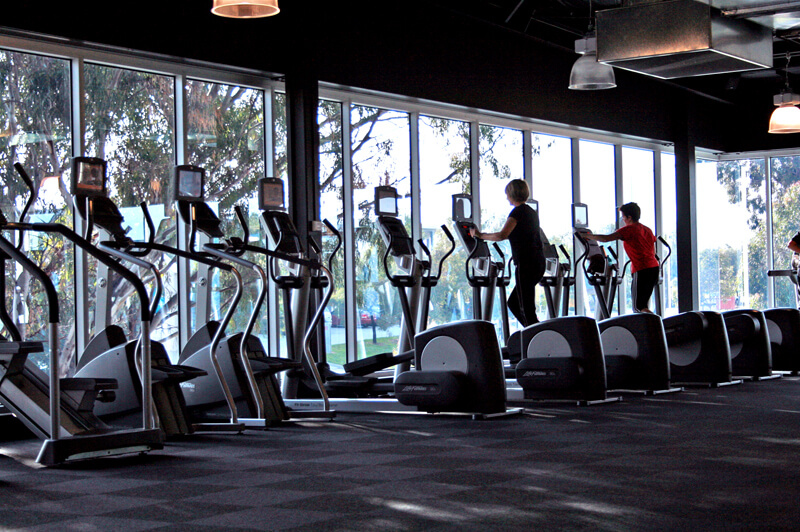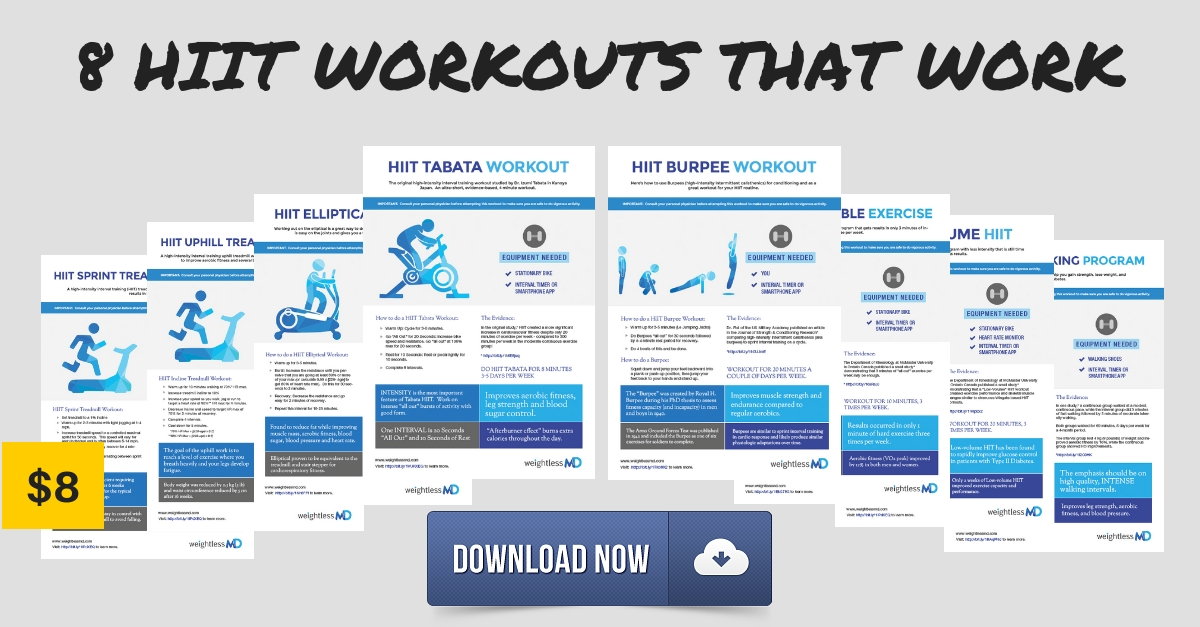Learn how to do high-intensity interval training (HIIT) with the elliptical.
The elliptical is a strange machine.
A hybrid. . . somewhere between a bike, treadmill and a stair stepper.
An ugly device with two pedals and two handles that when moving emulates your running motion.
I am not trying to be down on the elliptical, it has it’s place.
The elliptical machine is a product developed in the ‘90s as a cross trainer that promoted upper and lower body exercise in one workout. Despite limited evidence of effectiveness, these machines made it into every exercise facility in America.
Talk about marketing.
More recently, however, when an elliptical goes toe-to-toe with a treadmill and a stair climber it does just fine.
Benefits of the elliptical (and the science)
A 2004 study from Journal of Sports Medicine and Physical Fitness showed equal effectiveness in cardiorespiratory fitness improvements between the stair climber, elliptical and treadmill when adjusted for training volume and intensity in females during a 12 week program.
Also, one study found that the perceived exertion of exercise on an elliptical is less. The Journal of Sports Medicine and Physical Fitness found that people rate their exertion to be less than expected based on their Vo2 Max and heart rate.
This means that a workout on the elliptical may feel more comfortable.
So far not bad.
The elliptical has always been considered low-impact . . . your feet sit in pedals and never leave – there is no jarring of your joints. So, presumably your ankles, knees and hips would not get beat up.
However, there are no controlled trials on whether an elliptical is better for those with lower body arthritis or that an elliptical would prevent arthritis or injuries.
A 2014 study from the journal Gate and Posture does show that the elliptical has significantly reduced weight-bearing compared to walking and jogging.
So joint protection is plausible.
However, little is really known and one study form the journal Clinical Biomechanics shows that compared to walking, different leg muscles are activated and the lumbar back extension and flexion angles are different. This says nothing in regard to whether an elliptical is good for the back or that it is any better at toning your glutes or thighs.
What about High-Intensity Interval Training on the Elliptical?
I am most interested in high-intensity interval training . . . specifically to help my patients lose weight and get rid of diabetes with HIIT workouts.
Fortunately, the highest quality evidence regarding the elliptical used high-intensity interval training.
One study in 2014 found that going “all out” on the elliptical for 30 seconds may be more anaerobic than the traditional Wingate cycling all-out test. Triggering the anaerobic system seems to be an important piece to the HIIT puzzle and is necessary for muscle adaptations.
A study from the Journal of Strength and Conditioning Research in 2014 specifically looked at high-intensity interval training with an elliptical.
This 12-week study took 16 patients with diabetes or pre-diabetes and had them complete HIIT on the elliptical 3 times per week for 12 weeks.
They found improvements in several bio-markers:
- Fasting blood glucose
- Waist and hip circumference
- Appendicular (skeletal) fat mass
- Leg lean body mass
- Appendicular lean body mass
- Systolic blood pressure
- Resting heart rate
- VO2 max (a measure of cardiorespiratory fitness)
This is good news.
It appears that the elliptical has benefits in several biomarkers. This is not a comparison study – so we cannot make claims on whether the elliptical is better than cycling, treadmill running or any other form of exercise.
But what we can say is that using the elliptical to perform high-intensity interval training is likely to be effective and may help you lose fat mass, increase cardiorespiratory fitness and may help to prevent or stop diabetes.
Not bad.
So, lets review . . .
The benefits of the elliptical trainer
- Full upper and lower body workouts
- Lower impact exercise may protect the joints
- Available in every workout facility in America (and quite possibly in your own basement)
- Proven to be equivalent to treadmill and stair stepper for cardiorespiratory fitness
- HIIT program shows numerous bio-marker benefits
- May help with fat loss and diabetes (limited data however)
So, lets get started with how to do a HIIT elliptical workout . . .
How to do High-Intensity Interval Training on an Elliptical
Find a machine near you and hop on.
Grip the handles lightly and act like you are running. Alternatively you can let go of the handles and pump your arms as if you are running.
Don’t lean forward. Let your legs support you and let your legs glide back and forth.
Warm up for at least 3-5 minutes.
After the warm up you can increase the resistance until you perceive that you are going at least 80% or more of your max (or calculate 0.80 x [220- age] to get 80% of heart rate max). Do this for 30 seconds, up to 2 minutes. Then decrease the resistance to make it easy for 2 minutes of recovery.
Repeat.
Consider doing intervals for 10-20 minutes of exercise and then cool down.
Just to prove this workout can be a beast – here is a great video of Dr. Mercola doing a HIIT routine on the elliptical.
https://www.youtube.com/watch?v=zy7j9FRiJpg#t=583
In Summary:
The elliptical appears to be another good option to get a quality HIIT workout in. The elliptical is at least equivalent to treadmill and stair climber machines in improving your cardiorespiratory fitness and has been shown to improve blood sugar along with several other bio-markers. It may be a nice alternative for those with lower extremity joint issues as the elliptical has less weight bearing and possibly less stress on the ankles, knees and hips.
So, if it feels right for you, give this ugly machine a chance.
Related:
- HIIT for Weight Loss: The Science Explained
- Another Benefit of HIIT: Appetite Suppression
- 4-minute Tabata HIIT Workout
- Burpee Workout for High-Intensity Interval Training (HIIT)
- An Interval Walking Program: To lose weight, get strong and beat diabetes
The Evidence:
- Leduc-Gaudet, et al. Effect of Elliptical High Intensity Interval Training on Metabolic Risk Factor in Pre- and Type 2 Diabetes Patients: A Pilot Study. Journal of Physical Activity and Health, 2014.
- Kaplan, et al. Referent body weight values in over ground walking, over ground jogging, treadmill jogging, and elliptical exercise. Gate and Posture, 2014.
- Batte, et al. Physiologic response to a prescribed rating of perceived exertion on an elliptical fitness cross-trainer. Journal of Sports Medicine and Physical Fitness, 2003.
- Ozkaya, et al. An Elliptical Trainer May Render the Wingate All-out Test More Anaerobic. Journal of Strength and Conditioning Research, 2014.
- Egana, et al. Physiological changes following a 12 week gym based stair-climbing, elliptical trainer and treadmill running program in females. Journal of Sports Medicine and Physical Fitness, 2004.
- Moreside, et al. How do elliptical machines differ from walking: a study of torso motion and muscle activity. Clinical Biomechanics, 2012.
Image Credit: www.localfitness.com.au (accessed via wikepedia)


